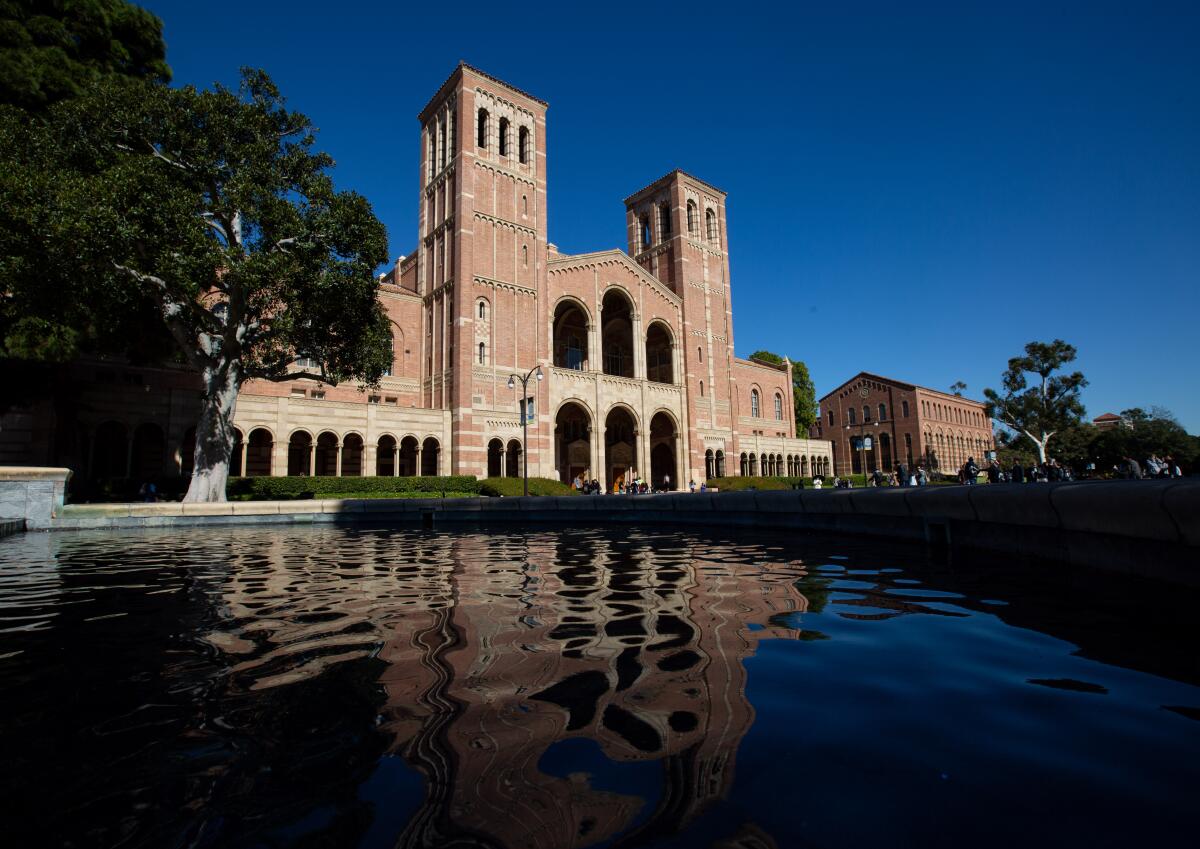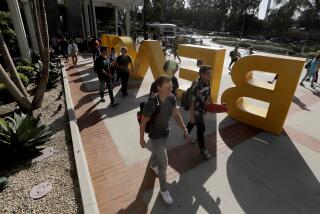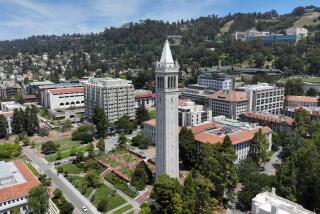Top UC campuses would reduce out-of-state student admissions, add Californians under proposal

- Share via
Three top University of California campuses — UCLA, UC Berkeley and UC San Diego — would reduce their share of out-of-state and international students to make way for more local residents, and the UC system would admit 6,230 more freshmen in 2022, under an amended state budget bill posted Friday.
The legislation pledges to deliver by 2022 what would be the largest single-year infusion of state funds to increase California student enrollment at UC campuses. The proposal comes after the university system was inundated by a record number of applications for fall 2021 in a year of high emotion and myriad questions over the admissions process and frustration over the lack of seats for qualified students.
The state would provide enough funding to reimburse the campuses for the loss of nonresident supplemental tuition, which amounts to nearly $30,000 per student and $1.3 billion collectively each year.
The higher education spending numbers were included in an amended budget bill posted online Friday before Gov. Gavin Newsom and Democratic leaders reached an agreement later in the night on the $262.6-billion state budget.
Another document summarizing the points of their agreement includes what legislative leaders say is the largest expansion of Cal Grant financial aid to date. The summary noted that the figures were preliminary and that details in both documents could change before legislators vote on the bill next week.
Under the proposed budget bill, the state would pay UC to reduce nonresidents at the system’s three most sought-after campuses, from more than 22% of undergraduates to 18%, over five years beginning in fall 2022. That would make room for about 4,500 additional California students over that period.
In addition to the 900 seats freed up each year by lowering the share of nonresident students at UCLA, UC Berkeley and UC San Diego, the state would provide funds to enroll the additional California freshmen in fall 2022, with President Michael V. Drake and the nine undergraduate campuses to decide how to split the money.
California State University would receive funds to add 9,434 more freshman seats over the previous year in fall 2022. The state would provide $180 million to cover the UC and Cal State enrollment expansion.
Newsom and Democratic legislators also agreed to create a new $2-billion fund to expand UC and Cal State facilities to accommodate more students and provide more student housing for the two systems, along with the California Community Colleges.
And the state would provide $154 million so that the main Cal Grant can be given to 133,000 community college students this fall who would not otherwise have qualified under rules that favor those who enroll within a year of graduating high school. The bill would eliminate that restriction, broadening access to older students.
Also, for the first time the state would provide an extra $515 million to recipients of middle-class scholarships to help cover some nontuition costs such as housing and food. Legislators say the actions mark the first step in a longer-term plan to enable California students to finish college without debt.
The proposed expansion comes at a critical time for hundreds of thousands of California students struggling under college costs, surging student loan debt and increased financial hardship triggered by the COVID-19 pandemic.
“This is a transformational budget,” said Assemblyman Kevin McCarty (D-Sacramento), who heads the Assembly subcommittee on education finance. “We will be funding the largest expansion of higher education access in a generation.”
The Friday budget bill includes $4.6 billion for UC, including $175 million for deferred maintenance and energy efficiency projects, $20 million for student mental health, $15 million for basic needs, $22.5 million for academic preparation programs, $15 million for emergency financial assistance for low-income students and $4 million for summer financial aid.
Programs to train medical professionals for underserved areas, legal services for immigrant students and research into firearms violence and dyslexia would also receive funding.
The 23-campus Cal State system would receive $5.2 billion, including $458 million to transition Humboldt State to a polytechnic campus focused on science, technology, engineering and math. Cal State Northridge would receive $25 million to create a center to increase equity in science, technology and math.
An additional $325 million would be funneled to the state universities for deferred maintenance and energy efficiency projects, $30 million for emergency financial aid for low-income students and $15 million for student basic needs.
Although the amended budget bill did not specify the base funding increase for UC and Cal State, it amounted to 5% in Newsom’s revised May proposal.
But the move to significantly reduce out-of-state and international UC students tackles an issue that has long drawn heat from Californians and has sparked furious debate over who should get a coveted seat in the nation’s premier public research university system.
The issue has prompted a scathing state audit, UC admission reforms and extensive policy work around ways to accommodate the growing number of qualified California applicants amid limited funding and space.
“It’s a punch one and punch two — people apply with phenomenal grades and they don’t get in, and then they realize the person that got their slot is an out-of-state student,” McCarty said. “It’s infuriating for California taxpayers.”
UC chancellors, however, have a different view.
“Nonresident students are enrolled only in addition to, and never in place of, qualified California students,” said UC San Diego Chancellor Pradeep Khosla. “As state funding declined, the enrollment of nonresident students helped offset tuition costs for California students and provided revenue that enabled us to improve educational programs for all students.”
He said nonresident student tuition helps recruit and retain high-quality faculty members, launch additional courses that help lower class size, increase library collections, renew instructional equipment and contribute to financial aid for Californians.
UC campus leaders say they’re gratified that the state will compensate their campuses for the loss of nonresident revenue. Shane White, UCLA’s Academic Senate chair, called it a “step in the right direction” but added that the fundamental issues over nonresident students have yet to be analyzed — including why the systemwide cap on them was set at 18% in 2017. UC regents allowed UCLA, San Diego, Berkeley and Irvine to grandfather in their higher shares.
UC Berkeley Chancellor Carol Christ said an important “reality check” is that the current state allocation for each California student doesn’t cover the actual cost of instruction, a gap filled by nonresident tuition.
“Replacing out-of-state students with Californians thus creates a budget gap that needs to be filled,” Christ said. “Even more important, out-of-state and international students contribute significantly to the diversity of the student experience, and the majority of these students remain in California after they graduate.”
The state provides $10,886 per student to cover its share of the cost of instruction, a calculation that includes faculty salary and benefits, teaching assistant time, instructional equipment, academic support and student services. But that figure falls about $6,000 short of covering the actual cost per student at Berkeley, according to UC data. So some campus leaders are nervous about the specter of losing nonresident students and the financial safety net of their tuition revenue.
Still, the plan included in the budget legislation is significantly scaled down from a state Senate proposal unveiled last month to reduce the proportion of nonresident incoming freshmen to 10% from the current systemwide average of 19% over the next decade beginning in 2022.
Legislators said at the time that the state’s record $75-billion surplus provided a rare and opportune moment for bold action to radically open up UC access — especially at its most competitive campuses.
Assemblyman Phil Ting (D-San Francisco) said that “limited resources” led legislators to shelve the larger plan for now and focus on the three most popular campuses but that more action was possible down the road. “We still want to get to 10%, but it makes sense as a first step to focus on those three campuses,” he said.
UC officials say they share the goal of enrolling and graduating more California students and have added 19,000 more California undergraduates since 2015. They opposed the 10% plan, however.
“We understand and support the Legislature’s goal of providing more opportunities for Californians at UC, though we believe trying to achieve this through reducing nonresident students will potentially lead to unanticipated outcomes,” the university system said in a statement.
More to Read
Sign up for Essential California
The most important California stories and recommendations in your inbox every morning.
You may occasionally receive promotional content from the Los Angeles Times.











